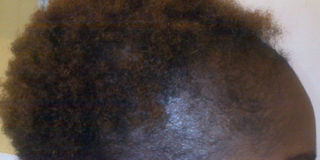Can hair dye be a health hazard?

Testing the dye before it is used on the hair reduces the risk of developing adverse allergic reactions on both the hair and skin. file photo
What you need to know:
But for 26-year-old Mercy Atim, a hair colouring session turned into a nightmare that left her hospitalised.
For long, hair dye or colouring has been a trend associated with young people. Today, it cuts across all ages, with many women and men having their hair, beard and eyebrows coloured. Many youth say it gives them a bold, more fashionable look while most adults use it to cover greying hair.
But for 26-year-old Mercy Atim, a hair colouring session turned into a nightmare that left her hospitalised.
“I was an 18-year-old student who had just completed high school. When I arrived at the salon, I did not bother to find out the type of chemicals that was going to be used. The hairdresser applied the mixture and said it would take 20 minutes before my hair would be washed,” says Atim.
Instead, after a few minutes, Atim’s scalp started itching. “The hair dresser said it was a normal reaction, especially for first time users and said everything would go well,” Atim remembers.
However, the itching became persistent, forcing the hairdresser to wash off the dye.
When it got worse, Atim was taken to hospital, where doctors said she had developed dermatitis, a reaction caused by certain chemicals found in bleaching products. She was given antibiotics to stop the pain and itching.
“Although the treatment was helpful, it left my scalp with several scar-like patches. These days, I keep my hair short and I avoid the sun,” says Atim. According to Anita Wito, a professional hairdresser at Suqa Salon, hair colouring or dyeing involves treatment of the hair with various chemical compounds.
“The dye also have chemicals that reduce hair elasticity, which can be classified in four categories including bleach and highlights, natural colorants, semi-permanent and permanent,” explains Wito.
Natural colorants
These contain pigments such as henna, lemon and black walnut shells. They generally work by coating the hair shaft with colour.
But even with the natural effects, people are advised against using colorants for more than two months continously.
Bleaching
Bleaching agents can also be used to change the colour of the hair. The bleach reacts to the melanin on the hair, removing the colour in an irreversible chemical reaction.
“This process decolourises the pigment in the hair shaft, which is why bleach will turn hair almost white if it is left on the scalp for a long period of time after initial application,” explains Wito.
Temporary hair dye
Temporary or semi-permanent dye does not need to be pre-mixed. They can last for up to two months on the hair and tend to fade gradually. “Since temporary hair dyes do not contain bleach, they easily be washed when shampoo is applied on the hair, or when it is exposed to air,” says Wito.
Permanent hair dye
The permanent dye can be more damaging because of the strong chemicals found in them, and because they last longer on the hair,” explains Wito.
Medical risk
Dr Martin Ramin, of Mukwaya Hospital, Nsambya, says hair dyes cause several negative reactions including severe allergy to the skin, some cancers-related illnesses and a problem of self-esteem. Thi protein causes allergic reactions which lead to dermatitis or severe itching of the scalp.




